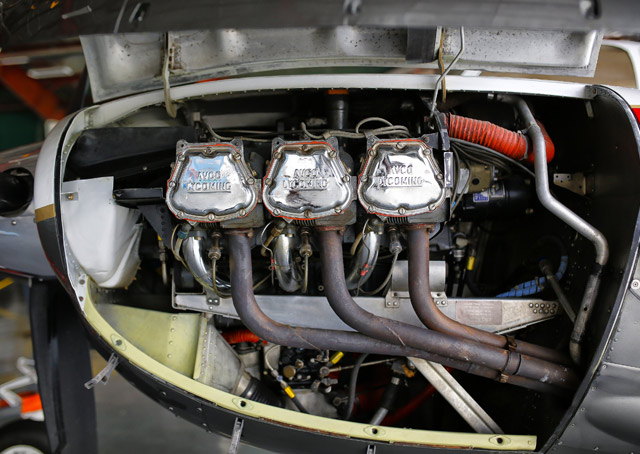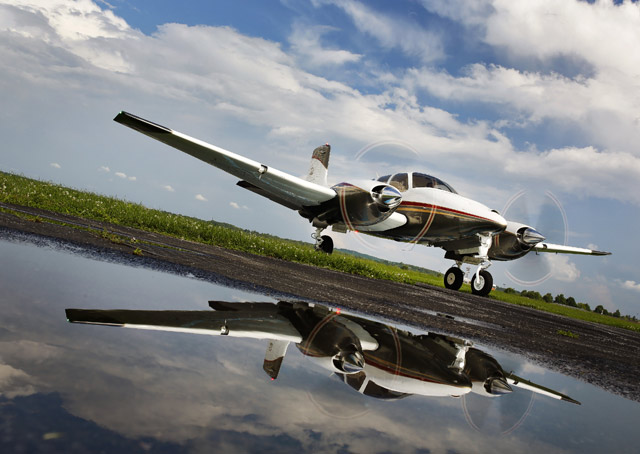Dale Egan is not foolhardy, and he’s certainly not impulsive. He’s a patent and corporate attorney with the necessary mixture of technical know-how and attention to detail. So how does a guy with a job rooted in logic spend a big chunk of money on an airplane restoration project that can compete only for most dollars per knot?
This is a project primarily justified by emotions, and one with which the owner must have an unhealthy obsession. That’s not to say it’s all irrational; there is a small bit of logic to the Twin Bonanza. This is especially true when you compare restoration costs to new choices on the market. But more than anything, Egan’s project was born of a love affair with the classic, cool, stout twin from Beechcraft.
The emotional argument
It was love at first sight. Egan was a relatively new pilot with about 600 hours, and Skyhawks and Archers didn’t light his fire. Milling around a hangar with some friends, he noticed an old Twin Bonanza in the back—the first he had ever seen. He was completely drawn to the beast lurking in the shadows. Egan’s friends, whom he says were anxious to leave, didn’t see the appeal. Maybe they knew of its geared and supercharged engines, complex systems, and unremarkable cruise speed—and considered the underlying statistics uninspiring.
But Egan wasn’t deterred. He lingered, studying every inch. In the years that followed he researched everything he could about the T-Bone (one of a few affectionate nicknames).
Although nicely restored examples come on the market occasionally, Egan decided he wanted a challenge. He settled on a 1961 model that had a few hundred hours on each engine; the rest of us would have considered it a great fly-away airplane. He immediately turned over the keys to a shop to rip it apart. It’s not that Egan has champagne tastes—he’d just prefer to grow the grapes. With a history of restoring cars, boats, and houses, it’s that process of tearing down and building back up that drives him. He considers restoration an art form. “I like to get in the mind of the guys who designed it,” he says. “And to do that you have to take it apart.” The goal was to use the image of the T-Bone as it was when it came out of the Beech factory as a guide.
To that end, the finished product was the primary goal, and money was a second or third consideration. “About 20 percent into it, we decided we had to go all-in,” Egan says. “Sometimes in restorations you spend more time figuring out what’s good enough when everyone knows what is the best. It can be easier to just do the best option right away. ” In all, it took more than two years and well into the six figures. There was paint, interior, and a new panel, which is a bit of an understatement.
Let’s start outside. Egan commissioned Scheme Designers (see “P&E: The Most Imitated Man in Aviation,” p. 100) to create a custom look that gives a nod to the airplane’s military past without implying it’s a poor man’s warbird.
It goes deeper. Egan said he made a pledge in the beginning that he didn’t want any skin patches. Years of avionics changes and upgrades meant the airplane’s skin was starting to look like an old inner tube. Every panel with an existing patch was replaced—and then some. Surprisingly, every one of the dozen or so pieces he needed was available from Beechcraft. “Sometimes it wasn’t necessary to replace a skin or other part,” he says. “But when you start to skimp, you are giving the impression to the artists that do this work that they need to skimp, too. Maybe not financially, but emotionally and with their time.”
The rudder, flaps, and ailerons were replaced, as were the wing tips. New LEDs adorn the inside and outside, and the few antennas that remain are new. So are all the windows.
Inside is where things get to another level. Egan personally fabricated new Russian Baltic Birch floorboards. The headliner and bulkhead panels are new. The seats are a beautiful cream-colored leather, and the Beech emblem on the seatbelt buckles adds a stately touch.
The front office is a perfect mix of modern technology and classic styling. The yokes are new. Almost 170 pounds of old avionics were removed, including the radar and many remote boxes. What remains is a nice, relatively modest panel centered around an Aspen primary flight display and two Garmin GTN 750s. Egan says this is an interim step. “We’re waiting for technology,” he says. The goal is to have an integrated retrofit solution in the same vein as the Garmin G1000.
To truly appreciate a nice T-Bone, you have to see it in person. The ramp presence is extraordinary. From far away it looks like any other small twin, but as you get closer it starts to fill in the scene, and it looms over you. It is big in every way. It’s tall; the gear is massive, the wingspan broad, and the cowlings fat. You enter, not through the front or up on the wing, but through a proper airstair door. You sit high and straight up front; flying it evokes the feelings of a much larger airplane.
When he first bought it, Egan says there was a moment that he stared at the airplane, thinking, Where the heck am I going to put it? Its massiveness definitely speaks to a past era, he says, and there’s no question an airplane like the Twin Bo would never come out of Wichita today. Which, strangely, leads to the logical arguments for the project.
The logical argument
Egan’s Twin Bonanza is—give or take—the same investment as a new Skyhawk. It’s less than half the cost of a new Baron. This is where things start to make sense. No, he could never sell the airplane for what he has in it, but neither could the owner of a new airplane. The T-Bone is exactly what Egan wants, and the performance—while it’s not going to set any records—does have some interesting footnotes.
Developed for a military contract, the Twin Bonanza is much more a baby King Air than a Bonanza with two engines. In fact, the name is a bit of a misnomer because the landing gear and wing became the Queen Air, which then became the King Air. A Baron is a twin (lowercase) Bonanza.
There’s a legend around the airplane’s strength that appears to be as true as it is funny. When demonstrating the Twin Bonanza for some military procurement folks, Beech factory pilot Claude Palmer pancaked in over a tall tree and landed so hard that there were fears of serious injuries. Palmer needn’t have worried about his passengers and his job, because everyone walked away. Beech won the contract.
The Twin Bonanza, then, fit one of Egan’s requirements for an airframe with the strength that comes inherent in a military pedigree. He also looked at the Navion, but living in Milwaukee means he spends a lot of time flying over the Great Lakes—where a second engine provided some stress relief. The ability to bring, as he says, five fat buddies and go fishing sealed the deal.
This is no hangar queen. On his third flight after the restoration, Egan flew some friends to a gathering in a barn next to a cornfield—and he has no hesitation taking it in and out of soft, short strips. In that sense it’s a wonderful utility aircraft. Have a Super Cub but wish you could bring five more friends? It’s that kind of airplane.
It’s also incredibly roomy inside and has long legs, which makes it a nice traveling machine. Just make sure to have your passengers bring lots to read, because you’ll only be doing about 160 or 170 knots along the way. That spacious interior has enabled Egan to complete some of his favorite flights thus far—transporting two Medal of Honor recipients to Washington, D.C., for special events.
The counter argument is that for the same money one could buy a different twin and a lot of avgas, or a smaller twin, lots of avgas, and a fun backcountry airplane. Egan would say that’s all irrelevant—and he’s right. Pilots tend to spend lots of time debating performance specifications, breaking down everything from cruise speed to best-economy, long-range endurance. You don’t buy an airplane like this and go on a multiyear quest to make it yours just because it gets you from Milwaukee to the Motor City five minutes faster. You do it because it speaks to you, it fits your specific mission, and—most of all—when you walk up to it you can’t help but say, “Cooool.” Because it most certainly is that.
Email [email protected]
Laundry list
Details of the restoration
Here’s a list of some of the restoration tasks on Egan’s airplane:
• New custom paint scheme
• New interior
• New floorboards
• New interior panels
• All new avionics
• New engine control cables
• A dozen new skins
• New flight control surface
• New LED and HID lights
• New windows
• New wing tips
• Removed vacuum pumps
• Removed remote avionics boxes
• Removed radar
• Installed new landing gear actuator brackets
• New yokes
• New tires
• Overhauled brake master cylinders
• Installed new gas caps
• New augmentor tubes
• New antennas
• Installed Rosen sun visors
History lesson
A well-done T-Bone
Despite the name, a Twin Bonanza is not a Bonanza with two engines. Take a Bonanza fuselage, cut it lengthwise, stick in some extra metal before sewing it all back up, and you’re close to the cabin size. However, the wing, landing gear, and engines all were new to this model.
In fact, it was the T-Bone that, with the addition of a larger cabin and engines, became the Queen Air. Add turbine engines and you have a King Air.
The Army purchased the first 216 of the nearly 1,000 Twin Bos built, dubbing it the L–23 Seminole. It served primarily as a utility transport in Korea.
Today, thanks to the steep drop in twin prices and the daunting geared and—for some models—supercharged Lycoming GSO-480 engines, you can find one for anywhere between $75,000 and $150,000. –IJT
SPEC SHEET
Beechcraft Twin Bonanza D50E
Specifications
Powerplants | (2) Lycoming GO-480-G2F6
Recommended TBO | 1,400 hr
Length | 31 ft 6 in
Height | 11 ft 6 in
Wingspan | 45 ft 11 in
Seats | 7 Maximum
Cabin width | 4 ft 6 in
Cabin height | 4 ft 4 in
Empty weight | 4,100 lb
Max gross weight | 6,300 lb
Fuel capacity | 180 gal
Performance
Takeoff distance, ground roll | 905 ft
Takeoff distance over 50-ft obstacle | 1,260 ft
Rate of climb, sea level | 1,450 fpm
Single-engine ROC, sea level | 365 fpm
Max level speed, 2.500 ft | 186 kt
Cruise speed/endurance (fuel consumption, ea engine) w/45-minute reserve
@ 65% power | 175 kt/6 hr
9,000 ft | (13.1 gph)
Service ceiling | 20,000 ft
Single-engine service ceiling | 8,700 ft
Landing distance over 50-ft obstacle | 1,455 ft
Landing distance, ground roll | 700 ft
VS1 (stall, clean) | 73 KIAS
VSO (stall, in landing configuration) | 62 KIAS
All specifications are based on manufacturer’s calculations. All performance figures are based on standard conditions and maximum weights unless otherwise noted.















